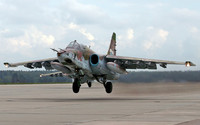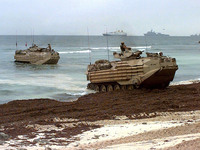Part 9: Episode 10: Better Jet Mission
Episode 10: Better Jet MissionYouTube: http://www.youtube.com/watch?v=_OtRH1leIM0
Seriously, what was the point of this mission? I made it like ten feet in 25 minutes.
The Weapons of Battlefield 3
The SU-25 “Frogfoot”

Seen in this mission and in multiplayer as the Russian counter to the A-10 Thunderbolt, the SU-25 is a slower moving, heavily armored plane produced in Russia and flown by a number of former Soviet States, African Nations and some Middle Eastern countries. The SU-25 started life in the same manner as the A-10 in the US. In the late 60’s the Soviet Ministry of Defense saw a need for a close support, heavily armored jet and began requesting designs and prototypes. The need for a rugged plane that could withstand the impact of small arms fire and the occasional rocket blast meant that the planes either in development or deployed just couldn’t fit the mission profile as requirements of a close attack craft were different from that of a fighter-bomber. Famed Belarusian aerospace engineer Pavel Sukhoi and his eponymous Sukhoi Design Bureau began design work in 1968, ahead of the call for the Close Support Craft and began turning out a set of prototypes, the T8-1 and T8-2 that would see completion in 1974. The first flight of these models would take place in 1975 and continue most of the year. At the end the T8 models were found to be superior and Sukhoi was recognized as the winner of the competition. Production of the first SU-25s began in 1978 in Tbilsi, Georgia at Factory No. 31, which was making MiG trainer craft at the time.
The SU-25 had an interesting design, making use of titanium to protect the pilot and flight instruments much like the A-10, but with a more traditional engines at wing profile. The wings themselves are long and carry five hardpoints for weapon mounting and air brake housings at the tips. The engines were originally non-afterburner turbofan engines (high bypass ratio and a dual shaft setup) and had additional cooling air brought in from the top of the engine nacelles. A cannon is mounted directly under the cockpit to a strut that is bolted to the “bathtub.” The cannon is not as cool as the A-10’s.
Unlike the A-10 the SU-25 didn’t have to wait long between introduction and active service. In 1981 the SU-25 went along with the 200th Independent Attack Squadron to western Afghanistan with the goal of attacking mountain refuges of the Mujahideen. By the end of the war in 1989 the average SU-25 had conducted a sortie a day between the 50 deployed. A total of 21 of the aircraft were lost in that time, an amazing figure when you realize just how prevalent they were in the conflict.
The SU-25 is a heavily exported plane, and is currently the only armored attack plane in production, thus it has become popular with countries looking for cheap, reliable and hardy close attack craft. In 1987 the Iraqis deployed SU-25s against Iran, only one was shot down by the time the war ended a year later. The Gulf War would see the effective end of the Iraqi Air Forces’ SU-25 fleet, though as American air forces eliminated SU-25s before they could leave the ground. Seven made it to Iran without incident and a few were shot down near the Saudi border.
Despite all this the SU-25 excels at what it was meant to do: Providing close air support and attacking stationary and ground targets. Many nations rely on it for “anti-insurgency” strikes. The Russians have continued design and re-design work on the SU-25 over the years, introducing the SU-25T, SU-25TM and eventually the SU-25SM packages. The first two are different planes meant for anti-tank roles, while the last is an upgrade package. The T and TM versions were overly expensive and unsuccessful, but the SM has had some success by offering a cheap upgrade that also reduced weight (thereby increasing fuel efficiency).
In BF3 the SU-25 is actually the TM version of the plane and a near carbon copy of the A-10, featuring high damage tolerances (disabling at 30% instead of 50% like the fighter jets) and no afterburner. The SU-25 is best used against armor and infantry, through many SkyLords will attempt to start dogfighting battles. Like all jets the Frogfoot can equip guided or heat seeking missiles along with rocket pods as secondary weapons. Rocket pods nicely expand the ground attack abilities of the Frogfoot, but most players run heat seekers to deal with other jets or helicopters. Frogfoots usually die due to geometry instead of enemy action, as the dive bombing nature of the jet creates close calls, especially when attacking heavily armored vehicles. A shallow angle of attack and a slowed attack run will leave a bit more space between the plane and the ground at the end, but makes the plane a target for dumbfire rockets and shells.
The AMTRAC

Also known as the AAV-7A1, the AMTRAC is a troop transport in service with the US Marines and is exclusive to that faction in BF3. AMTRAC is a shortened description for the family of vehicles the AASV-7A1 belongs to, the Amphibious Tractor. This sort of vehicle has been around since the mid 30’s and has seen civilian and military variants and models since then, with the BF3 AMTRAC being just one of many of these designs. The AMTRAC is meant to be able to deploy assault forces and all their required gear and equipment on dry ground while also providing cover and protection against enemy forces. AMTRACs make use of treads like a tank instead of wheels and can rotate while stationary, which adds an element of maneuverability to a 26 foot long, 10 foot wide armored vehicle.
The AMTRAC entered service with the Marines during the Vietnam War in 1972, replacing an earlier Amphibious Tractor model and assigned the LVTP-7 designation on introduction. In 1982 the original designers, FMC Corp. won a contract for overhauling the LVTP-7s in service to the modern AAV-7A1 models. Among the improvements were the use of electrical turret controls, smoke grenade launchers, an improved diesel engine and new instrument panels for the crew. This also added a M2 Browning .50 caliber machine gun and Mk. 19 grenade launcher to the vehicle.
Other improvements would be rolled out in 1989 and 1993 that would improve armor, change ground clearance and improve the horsepower to ton ratio of the vehicle. The modern AMTRAC is crewed by 3 people and can seat 26 more Marines and their gear while moving at a top speed of 45 MPH on a paved road. In the water the AMTRAC is limited to a slow 8.2 MPH. Despite the long service and various rebuilds the Marines had intentioned to replace the AMTRAC by 2015 with the Expeditionary Fighting Vehicle that was better armored, armed and faster in the water than the AMTRAC. In 2011 the program was canceled and the Marines switched focus to the Amphibious Combat Vehicle program, which is still in extremely early stages, meaning the AMTRAC will be in service far beyond the original 2015 retirement date.
In BF3 the AMTRAC is an oddity. Unlike every vehicle in the game there isn’t a Russian counterpart, and a Russian team isn’t able to capture or use the vehicle, only destroy it. There also isn’t a leveling system for the AMTRAC as it falls into the “transport” vehicle category along with the transport choppers, jeeps and Humvee/Vodnik. Like the other transport land vehicles there are two “functional” seats in the AMTRAC, the driver and the gunner. While other seats are available, they have no weapons and are limited to looking out the side of the AMTRAC.
The AMTRAC serves as a mobile spawn point for American forces so long as it is active, leading to a need on some maps for American forces to protect a landed AMTRAC and for Russian forces to throw everything they have at it to keep the Americans from gaining a foothold . Taking out an AMTRAC is a daunting process as the vehicle has reactive armor by default, can deploy smoke and the gunner’s grenade launcher can kill a tank if given enough time. The AMTRAC has what engineers call “a shitton of hitpoints” and can survive multiple rockets, tank shells and mines. Where three C4 packages can kill a tank it can take five or six to down an AMTRAC. Smart teams will be able to keep an AMTRAC alive for extended periods of time and use it to pressure enemy capture points or MCOMMS with the grenade launcher and constant team spawns.